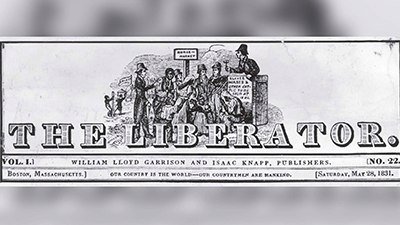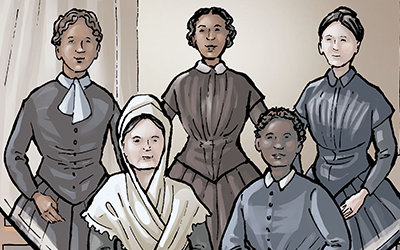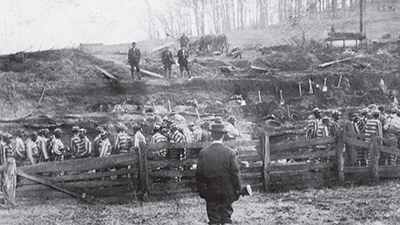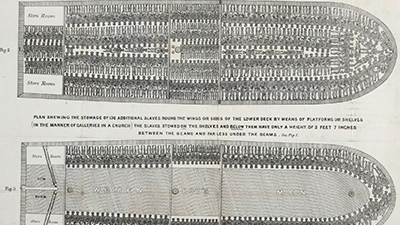Enslavement and Abolition
Driving Question: How did abolitionist movements reshape political and economic structures during the long nineteenth century?
Even as liberty became a global ideal, slavery remained a global reality. Resistance came from enslaved people, activists, and communities who refused to accept the system. Even with the abolition of slavery, the fight for equality was far from over.
Learning Objectives:
- Analyze the factors that led to the abolition of slavery and its lasting impacts on modern society.
- Use the historical thinking practice of sourcing to evaluate theories about the abolition of slavery.
- Use a graphic biography to support, extend, or challenge the overarching narratives of this period.
Vocab Terms:
- abolitionist
- activism
- capitalism
- enslavement
- plantation
- racism
- slave trade
Opener: Enslavement and Abolition
To teach this lesson step, refer to page 2 of the Lesson 4.4 Teaching Guide.
In this lesson, you are going to learn about individuals and groups who made important choices that transformed the world for the better. This quick opener will help you think through what drives decision-making.
Why Was Slavery Abolished?
To teach this lesson step, refer to page 3 of the Lesson 4.4 Teaching Guide.
Need a way to give students feedback on their sourcing skills? Check out this Sourcing Feedback Form.
These materials explore why slavery was abolished and highlight the role of abolitionist voices. You’ll use evidence to understand how abolition reshaped politics and the economy in the industrial age.
-
Guiding Questions
-
Before you read
Preview the questions below, and then skim the article. Be sure to look at the section headings and any images.
While you read
Look for answers to these questions:
- Which countries ended the slave trade or slavery early? Which ended it late?
- How did capitalism and industrialization help bring slavery to an end?
- How did changing beliefs about morality and human rights help end slavery?
- How did African and African-descended communities work to end slavery?
- Did slavery really end when it became illegal?
After you read
Respond to these questions: Which argument for why slavery ended do you find most convincing? Why?
-
Guiding Questions
-
Before you read
Preview the questions below, and then skim the comic, paying attention to things like prominent colors, shapes, and types of text and fonts. How do you know where to start and in which direction to read? What’s in the gutters (the space between panels)? Who or what is the focus of the comic?
While you read
- What were Purvis’s family and community like while she was growing up?
- What happened when the Philadelphia Female Anti-Slavery Society held a national conference in 1838?
- How did Purvis and her husband fight against slavery and discrimination?
- What other reform movement did Purvis join? What impact did that movement have?
- What message is the artist sending by showing two women holding hands at the start, but separated at the end?
After you read
Respond to this question: How does Purvis’s story support or challenge what you’ve learned about social change and its limits in the nineteenth century?
Impacts of Enslavement
To teach this lesson step, refer to page 9 of the Lesson 4.4 Teaching Guide.
The Comparison One-Pager is a great reminder of why this skill is so important to understanding the past.
This article and video show how abolition changed societies—but also how racism and inequality continued in the political and economic systems.
-
Guiding Questions
-
Before you read
Preview the questions below, and then skim the article. Be sure to look at the section headings and any images.
While you read
Look for answers to these questions:
- Where was the first large post-abolition society? How did it form?
- When Britain ended slavery in the Caribbean, who got compensation? Why?
- How were formerly enslaved people still controlled in the British Caribbean?
- After the United States abolished slavery, how did the government treat African Americans?
- Why did European powers end slavery in their African colonies?
After you read
Respond to this question: How does this article deepen your understanding of the impact of reform movements in the long nineteenth century?
-
Guiding Questions
-
Before you watch
Preview the questions below, and then review the transcript.
While you watch
Look for answers to these questions:
- What was life like around Cape Coast before the Atlantic slave trade began?
- What does the structure of Cape Coast Castle reveal about the slave trade?
- What were some of the economic effects of the slave trade on the coastal region?
- How did the slave trade change how people lived in West Africa?
- How did visiting Cape Coast Castle affect Ato Ashun personally?
After you watch
Respond to this question: What do you think people should understand about the impact of the Atlantic slave trade on Ghana?
Key Ideas
Closer: Enslavement and Abolition
To teach this lesson step, refer to page 11 of the Lesson 4.4 Teaching Guide.
Closers like this are a great opportunity to informally assess student understanding. Read more in the OER Project Assessment Guide.
You’ve learned about the impacts of the slave trade and some of the people who helped end it. In this activity, you’ll choose the factors that you think were most important to the abolitionist movement.
Rival Economic Systems
To teach this lesson step, refer to page 11 of the Lesson 4.4 Teaching Guide.
Slaving and slavery existed alongside capitalism. But were they rival economic systems, or did they support each other?
-
Guiding Questions
-
Before you read
Preview the questions below, and then skim the article. Be sure to look at the section headings and any images.
While you read
Look for answers to these questions:
- Why does the link between slavery and capitalism still matter today?
- Why do some argue that capitalism should support free labor over enslaved labor?
- What evidence is used to show that slavery was inefficient for business owners in the United States?
- How were some industrialists connected to the abolitionist movement?
- What evidence suggests that the Atlantic slave trade helped spark industrial capitalism?
After you read
Respond to these questions: Which claim do you agree with more—that slavery helped build capitalism, or that capitalism helped end slavery? What evidence supports your choice?








